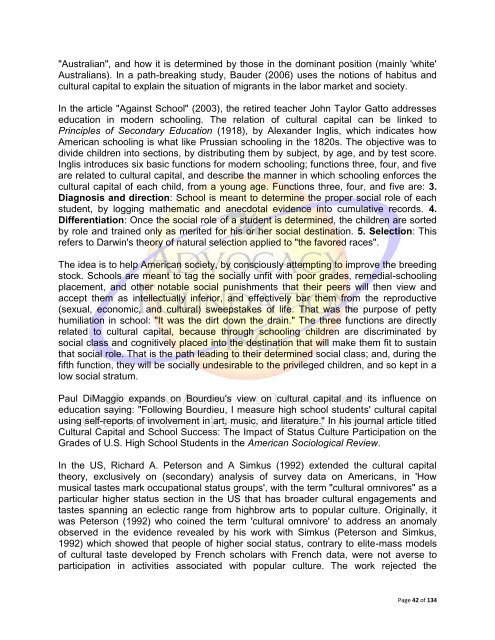Cultural Transformation
Cultural Transformation
Cultural Transformation
You also want an ePaper? Increase the reach of your titles
YUMPU automatically turns print PDFs into web optimized ePapers that Google loves.
"Australian", and how it is determined by those in the dominant position (mainly 'white'<br />
Australians). In a path-breaking study, Bauder (2006) uses the notions of habitus and<br />
cultural capital to explain the situation of migrants in the labor market and society.<br />
In the article "Against School" (2003), the retired teacher John Taylor Gatto addresses<br />
education in modern schooling. The relation of cultural capital can be linked to<br />
Principles of Secondary Education (1918), by Alexander Inglis, which indicates how<br />
American schooling is what like Prussian schooling in the 1820s. The objective was to<br />
divide children into sections, by distributing them by subject, by age, and by test score.<br />
Inglis introduces six basic functions for modern schooling; functions three, four, and five<br />
are related to cultural capital, and describe the manner in which schooling enforces the<br />
cultural capital of each child, from a young age. Functions three, four, and five are: 3.<br />
Diagnosis and direction: School is meant to determine the proper social role of each<br />
student, by logging mathematic and anecdotal evidence into cumulative records. 4.<br />
Differentiation: Once the social role of a student is determined, the children are sorted<br />
by role and trained only as merited for his or her social destination. 5. Selection: This<br />
refers to Darwin's theory of natural selection applied to "the favored races".<br />
The idea is to help American society, by consciously attempting to improve the breeding<br />
stock. Schools are meant to tag the socially unfit with poor grades, remedial-schooling<br />
placement, and other notable social punishments that their peers will then view and<br />
accept them as intellectually inferior, and effectively bar them from the reproductive<br />
(sexual, economic, and cultural) sweepstakes of life. That was the purpose of petty<br />
humiliation in school: "It was the dirt down the drain." The three functions are directly<br />
related to cultural capital, because through schooling children are discriminated by<br />
social class and cognitively placed into the destination that will make them fit to sustain<br />
that social role. That is the path leading to their determined social class; and, during the<br />
fifth function, they will be socially undesirable to the privileged children, and so kept in a<br />
low social stratum.<br />
Paul DiMaggio expands on Bourdieu's view on cultural capital and its influence on<br />
education saying: "Following Bourdieu, I measure high school students' cultural capital<br />
using self-reports of involvement in art, music, and literature." In his journal article titled<br />
<strong>Cultural</strong> Capital and School Success: The Impact of Status Culture Participation on the<br />
Grades of U.S. High School Students in the American Sociological Review.<br />
In the US, Richard A. Peterson and A Simkus (1992) extended the cultural capital<br />
theory, exclusively on (secondary) analysis of survey data on Americans, in 'How<br />
musical tastes mark occupational status groups', with the term "cultural omnivores" as a<br />
particular higher status section in the US that has broader cultural engagements and<br />
tastes spanning an eclectic range from highbrow arts to popular culture. Originally, it<br />
was Peterson (1992) who coined the term 'cultural omnivore' to address an anomaly<br />
observed in the evidence revealed by his work with Simkus (Peterson and Simkus,<br />
1992) which showed that people of higher social status, contrary to elite-mass models<br />
of cultural taste developed by French scholars with French data, were not averse to<br />
participation in activities associated with popular culture. The work rejected the<br />
Page 42 of 134

















